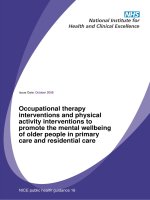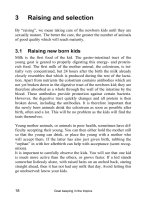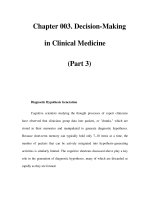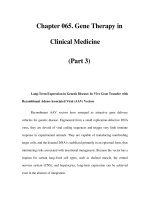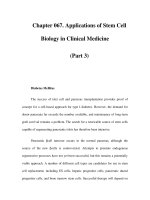Current practice guidelines in primary care - part 3 ppsx
Bạn đang xem bản rút gọn của tài liệu. Xem và tải ngay bản đầy đủ của tài liệu tại đây (129.87 KB, 23 trang )
34 DISEASE SCREENING: CANCER, THYROID
Disease
Screening Organization Date Population Recommendations Comments Source
CANCER, THYROID
Cancer,
Thyroid
AAFP 2007 Asymptomatic
persons
Recommends against the
use of ultrasound screen-
ing in asymptomatic per-
sons.
1. Neck palpation for nodules in
asymptomatic individuals has
sensitivity 15%–38%; specificity
93%–100%. Only a small proportion of
nodular thyroid glands are neoplastic,
resulting in a high false-positive rate.
(USPSTF)
/>home/clinical/exam.html
DISEASE SCREENING: CAROTID ARTERY STENOSIS 35
Disease
Screening Organization Date Population Recommendations Comments Source
Carotid Artery
Stenosis
(asymptomatic)
ASN 2007 Asympto-
matic
adults
Screening of the
general population
or a selected
population based
on age, gender, or
any other variable
alone is not
recommended.
1. The prevalence of internal carotid artery stenosis
(ICAS) of ≥ 70% is low in persons with only
atherosclerosis risk factors (1.8%–2.3%), intermediate in
those with angina or MI (3.1%), and highest in those with
PAD (12.5%) or AAA (8.8%). Advanced age (> 54
years) and lower diastolic BP (< 83 mm Hg) increased
prevalence of ICAS. (J Vasc Surg 2003;37:1226–1233)
2. Asymptomatic Carotid Surgery Trial (ACST) (Lancet
2004;363:1491): The absolute risk reduction for stroke or
death at 5 years was 5.4%, with significant benefit
observed in women (4% absolute risk reduction) as well
as in men (8.2% risk reduction).
3. Severe CAS and coexisting conditions: carotid stenting
with use of emboli-protection device is not inferior to
CEA. [NEJM 2004 Oct 7;351(15):1493–1501]
J Neuroimaging
2007;17:19–47
CAROTID ARTERY STENOSIS
36 DISEASE SCREENING: CHLAMYDIAL INFECTION
Disease
Screening Organization Date Population Recommendations Comments Source
Chlamydial
Infection
USPSTF 2007 Women aged ≤ 24
years who are
sexually active,
and older non-
pregnant women
at increased risk
a
Recommends at least
annual screening;
optimal interval for
screening is
uncertain.
b
1. Antigen detection tests, nonamplified nucleic acid
hybridization, and amplified DNA assays may provide
improved sensitivity, lower expense, availability, and/or
timeliness of results over culture.
2. Noninvasive methods such as urine specimens and
vaginal swabs appear reliable.
3. Early detection and treatment of women at risk for
chlamydial infection (prevalence 7%) reduced the incidence
of pelvic inflammatory disease from 28 per 1,000 woman-
years to 13 per 1,000 woman-years.
4. Recent population-based studies show overall prevalence of
chlamydial infection in persons aged 18–26 years to be
4.7%, with rates six-fold higher among African Americans.
Prevalence rates in men were 3.5%. (JAMA 2004;291:2229)
5. Prevalence of asymptomatic chlamydial infection among
military recruits age 18–25 was 8.5%. (South Med J
2007;100:478)
http://www.
ahrq.gov/
clinic/uspstf/
uspschlm.htm
CHLAMYDIAL INFECTION
USPSTF 2007 Pregnant women
aged < 24 years,
and older
pregnant women
at increased risk
Screen during first
trimester or first
prenatal visit.
DISEASE SCREENING: CHLAMYDIAL INFECTION 37
Chlamydial
Infection
(continued)
USPSTF 2007 Women aged ≥ 25
years
Recommends against
routinely screening
women aged ≥ 25
years, whether or not
they are pregnant, if
they are not at
increased risk.
CHLAMYDIAL INFECTION
USPSTF 2007 Men Evidence insufficient
to assess the balance
of benefits to harms
of screening.
a
Aged ≤ 25 years, new male sex partners or 2 or more partners during preceding year, inconsistent use of barrier methods, history of prior STD, African-American race, cervical ectopy.
b
For women with a previous negative screening test, the interval for rescreening should take into account changes in sexual partners. If there is evidence that a woman is at low
risk for infection (eg, in a mutually monogamous relationship with a previous history of negative screening tests for chlamydial infection), it may not be necessary to screen
frequently. Rescreening at 6 to 12 months may be appropriate for previously infected women because of high rates of reinfection. USPSTF (2005) also recommends screening
all high-risk sexually active women for gonorrheal infection.
Disease
Screening Organization Date Population Recommendations Comments Source
38 DISEASE SCREENING: CHOLESTEROL & LIPID DISORDERS
Disease
Screening Organization Date Population Recommendations Comments Source
Cholesterol
& Lipid
Disorders
USPSTF 2007 Infants, children,
adolescents, or
young adults (aged
< 20 years)
Insufficient evidence to recommend
for or against routine screening.
a
1. Effectiveness of treatment
interventions in children
with dyslipidemia remains a
critical research gap.
2. Age to stop screening is not
established. Clinical trial
data demonstrate that
persons older than 65 years
of age derive the same
benefit from cholesterol
reduction as younger adults.
3. Base treatment decisions on
at least 2 cholesterol levels.
4. Intensive lipid-modulating
therapy (LDL < 60 mg/dL;
increase in HDL ≥ 15
mg/dL) is associated with
plaque and atheroma volume
regression (the ASTEROID
trial). (JAMA
2006;295:1556)
/>uspstf/uspschlip.htm
Pediatrics
2007;120:e189–e214
CHOLESTEROL & LIPID DISORDERS
NCEP III 2004 Men and women aged
> 20 years
Check fasting lipoprotein panel (if
testing opportunity is nonfasting, use
nonfasting TC and HDL) every 5
years if in desirable range; otherwise
see management algorithm.
b
Circulation
2002;106:3143–3421
Circulation 2004;110:227–
239
/>guidelines/cholesterol/
atp3upd04.htm
DISEASE SCREENING: CHOLESTEROL & LIPID DISORDERS 39
Cholesterol
& Lipid
Disorders
(continued)
AAFP
USPSTF
2006
2001
Men aged 20–35
years
Women aged 20–45
years
Recommends routine screening of
individuals with major CHD risk
factors.
c
Optimal screening interval
uncertain.
Makes no recommendation for or
against routine screening for lipid
disorders in the absence of known
CHD risk factors.
/> />uspstf/uspschol.htm
CHOLESTEROL & LIPID DISORDERS
AAFP
USPSTF
2007
2001
Men aged ≥ 35 years
Women aged ≥ 45
years
Strongly recommends routine
screening for lipid disorders and
treatment of abnormal lipid in
people who are at increased risk of
CHD.
c
Random total cholesterol and HDL
cholesterol or fasting lipid profile,
periodicity based on risk factors.
Am J Prev Med
2001;20(35):73–76
/>Geriatrics 2003;58:33–38
/>uspstf/uspschol.htm
a
AHA: Low efficacy of targeted screening of children based on family history. Sensitivity and specificity of screening complicated by variability in total cholesterol and HDL
based on race, gender, and sexual maturation. (Circulation 2007;115:1948–1967)
b
Classify fasting TC < 200 mg/dL as desirable, 200–239 mg/dL as borderline, or ≥ 240 mg/dL as high. Classify HDL < 40 as low, and ≥ 60 as high. Classify LDL < 100 as
optimal, 100–129 as near or above optimal, 130–159 as borderline high, 160–189 as high, and ≥ 190 as very high. If TC < 200 mg/dL and HDL ≥ 40 mg/dL, then repeat in 5
years; if non-fasting TC ≥ 200 mg/dL or HDL < 40 mg/dL, then check fasting lipids and risk stratify based on LDL (see Management algorithm).
Advanced lipoprotein testing does not predict carotid intima-media thickness better than traditionally measured lipid values. (Ann Intern Med 2005;142:742
–750)
c
Hypertension, smoking, diabetes, family history of CHD before age 50 (male relatives) or age 60 (female relatives), family history suggestive of familial hyperlipidemia.
Disease
Screening Organization Date Population Recommendations Comments Source
40 DISEASE SCREENING: CORONARY ARTERY DISEASE
Disease
Screening Organization Date Population Recommendations Comments Source
Coronary
Artery
Disease
AAFP
AHA
USPSTF
2007
2007
2004
Adults at low
risk of CHD
events
a
Recommends against routine
screening with resting ECG, ETT, or
electron-beam CT for coronary
calcium.
b
1. Key questions to answer
in RCT are (1) effect of
testing asymptomatic per-
son on subsequent CHD
morbidity and mortality;
(2) effect in women;
(3) cost-effectiveness.
2. Specific recommendations
regarding non-invasive test-
ing in the evaluation of
women with suspected
CAD have also been pub-
lished. (Circulation
2005;111:682–696)
/>home/clinical/exam.html
/>uspsacad.htm
Ann Intern Med 2004;140:569
Circulation 2005;112:771–776
Circulation 2007;115:402–426
CORONARY ARTERY DISEASE
AHA 2007 Adults at
intermediate
risk of CHD
events
May be reasonable to consider use of
coronary artery calcium
measurement.
b
Circulation 2007;115:402–426
AAFP
AHA
USPSTF
2007
2007
2004
Adults at high
risk of CHD
events
a
Insufficient evidence to recommend
for or against routine screening with
ECG, ETT, or electron-beam CT for
coronary calcium.
b
Ann Intern Med 2004;140:569
/>home/clinical/exam.html
/>uspsacad.htm
Circulation 2005;112:771–776
DISEASE SCREENING: CORONARY ARTERY DISEASE 41
Coronary
Artery
Disease
(continued)
Third Joint
Task Force of
European and
other Societies
on Cardiovas-
cular Disease
Prevention
2003 Age ≥ 40 Estimate risk based on the SCORE
(Systematic Coronary Risk
Evaluation) system.
b
/>initiatives/prevention/
prevention-tools/SCORE-
Risk-Charts.htm
European J Cardiovascular
Prevention and Rehab. 2003;
10(Suppl 1): S1–S78
CORONARY ARTERY DISEASE
a
Increased risk for CHD events: older age, male gender, high blood pressure, smoking, elevated lipid levels, diabetes, obesity, sedentary lifestyle. Risk assessment tool for
estimating 10-year risk of developing CHD events available online or see Appendix V. ( />b
AHA scientific statement (2006): Asymptomatic persons should be assessed for CHD risk. Individuals found to be at low risk (< 10% 10-year risk) or at high risk (> 20% 10-
year risk) do not benefit from coronary calcium assessment. High-risk individuals are already candidates for intensive risk reducing therapies. In clinically selected,
intermediate-risk patients, it may be reasonable to use EBCT or MDCT to refine clinical risk prediction and select patients for more aggressive target values for lipid-lowering
therapies. (Circulation 2006;114:1761–1791)
Disease
Screening Organization Date Population Recommendations Comments Source
42 DISEASE SCREENING: DEMENTIA
Disease
Screening Organization Date Population Recommendations Comments Source
DEMENTIA
Dementia AAN
USPSTF
2004
2003
Elderly,
asymptomatic
Insufficient evidence to
recommend for or against
routine screening for
dementia.
1. Screening instruments are useful for
detecting multiple cognitive deficits
and determining a baseline for future
assessments.
b
2. Short Test of Mental Status (STMS)
slightly more effective than Mini Men-
tal State Examination (MMSE) in dif-
ferentiating between cognitively healthy
and MCI. (Arch Neurol 2003;60:1777–
1781)
3. Reversible causes of dementia include
vitamin B
12
deficiency, neurosyphilis,
and hypothyroidism. Be aware of other
causes of mental status changes, such as
depression, delirium, medication ef-
fects, and coexisting illnesses.
4. Homocysteine lowering with B vita-
mins and folate does not improve cog-
nitive performance in healthy older
adults. (NEJM 2006;354: 2764)
Ann Intern Med
2003;138:925–926
Ann Intern Med
2003;138:927–937
Neurology 2001;56:1133–1142
Neurology 2001;56:1143–1153
/>uspsdeme.htm
AAN
AGS
2003
2003
Elderly, mild
cognitive
impairment
(MCI)
a
Persons with MCI should be
evaluated regularly for
progression to dementia.
(Review of MCI: Lancet
2006;367(9518):1262)
/>
Neurology 2001;56:1133–1142
Mini Mental Status Exam: J
Psychiatr Res 1975;12:189, also
see Mini Mental State
Examination in Appendix I
Short Test of Mental Status: Mayo
Clinic Proc 1987;62:281–288
a
Triggers that should initiate an assessment for dementia include difficulties in (1) learning and retaining new information, (2) handling complex tasks (eg, balancing a checkbook
or cooking a meal), (3) reasoning ability (eg, a new disregard for social norms), (4) spatial ability and orientation (eg, difficulty driving, or getting lost), (5) language (eg,
difficulties in word-finding), and (6) behavior (eg, appearing more passive or more irritable than usual). DSM-IV diagnosis of dementia requires: (1) evidence of decline in
functional abilities and (2) evidence of multiple cognitive deficiencies. MCI criteria: memory complaint, preferably corroborated by an informant; objective memory
impairment; normal general cognitive function; intact activities of daily living; not demented. 6%–25% of MCI patients progress to dementia each year.
b
Articles comparing validated cognitive impairment screening instruments: J Neurol Neurosurg Psychiatry 2007;78:790–799. JAMA 2007;297:2391–2404.
Note: American Academy of Neurology website includes an “AAN Encounter Kit for Dementia,” a web-based algorithm to assist coding, diagnosis, and pharmacologic
management of cognitive disorders in adults (MCI and dementia). ( />DISEASE SCREENING: DEPRESSION 43
Disease
Screening Organization Date Population Recommendations Comments Source
Depression AAFP
CTF
USPSTF
a
2007
2005
2002
Children and
adolescents
Insufficient evidence to
recommend for or against
routine screening.
1. Clues to depression include poor school
performance, alcohol or drug use, and deteriorating
parental or peer relationships.
2. Clues to suicide risk include family dysfunction,
physical and sexual abuse, substance abuse, history
of recurrent or severe depression, and prior suicide
attempt or plans.
b
/>en/home/clinical/
exam.html
CMAJ 2005;172:33
/>uspstf/uspsdepr.htm
DEPRESSION
NICE 2005 Children and
young
adults (aged
5–18 years)
Healthcare professionals in
primary care, schools, and
other relevant community
settings should be trained to
detect symptoms of depres-
sion, and to assess children
and young adults who may
be at risk for depression.
e.
org.uk/CG28
Bright
Futures
2002 Adolescents Annual screening for
behaviors or emotions that
might indicate depression
or risk of suicide.
http://brightfutures.
aap.org/web/
44 DISEASE SCREENING: DEPRESSION
Depression
(continued)
AAFP
USPSTF
a
2007
2002
Adults Recommend screening
adults for depression in
practices with systems in
place to assure accurate
diagnosis, effective
treatment, and follow-up.
1. See screening instruments [Geriatric Depression
Scale, Beck Depression Inventory (Short Form),
PRIME-MD; PHQ-9] in Appendix I.
2. Optimal screening interval is unknown.
/>en/home/clinical/
exam.html
/>uspstf/uspsdepr.htm
DEPRESSION
NICE 2004 High-risk
groups
c
Recommend screening in
primary care and general
hospital settings.
.
uk/CG23/
a
Update in progress.
b
Suicide risk increases as the number of conditions increases. Parents of adolescents at risk for suicide should reduce access to firearms, weapons, or potentially lethal drugs in
the home.
c
High-risk groups: past history of depression, significant physical illness causing disability, other mental health problems such as dementia.
Disease
Screening Organization Date Population Recommendations Comments Source
DISEASE SCREENING: DEVELOPMENTAL DYSPLASIA OF THE HIP 45
Disease
Screening Organization Date Population Recommendations Comments Source
Developmental
Dysplasia of
the Hip (DDH)
USPSTF 2006 Infants Evidence is insufficient to
recommend routine screen-
ing for developmental dys-
plasia of the hip in infants
as a means to prevent ad-
verse outcomes.
1. There is evidence that screening leads to earlier
identification; however 60%–80% of the hips of
newborns identified as abnormal or suspicious for
DDH by physician examination and > 90% of those
identified by ultrasound in the newborn period
resolve spontaneously, requiring no intervention.
2. The USPSTF was unable to assess the balance of
benefits and harms of screening for DDH but was
concerned about the potential harms associated
with treatment, both surgical and non-surgical, of
infants identified by routine screening.
q.
gov/clinic/uspstf/
uspshipd.htm
DEVELOPMENTAL DYSPLASIA OF THE HIP
46 DISEASE SCREENING: DIABETES MELLITUS, GESTATIONAL
Disease
Screening Organization Date Population Recommendations Comments Source
Diabetes
Mellitus,
Gestational
(GDM)
AAFP
USPSTF
2007
2003
Asymptomatic
pregnant
women
Evidence is insufficient to
recommend for or against routine
screening.
1. High-quality evidence that
screening (vs. testing women with
symptoms) for GDM reduces
important adverse health outcomes
for mothers or their infants is
lacking.
2. Fasting plasma glucose ≥ 126
mg/dL or a casual plasma glucose
≥ 200 mg/dL meets threshold for
diabetes diagnosis, if confirmed on
a subsequent day, and precludes the
need for glucose challenge. (ADA)
/>online/en/home/
clinical/exam.html
/>clinic/uspstf/uspsgdm.
htm
DIABETES MELLITUS, GESTATIONAL
ADA 2007 Pregnant
women
Risk assess all women at first prenatal
visit. If clinical characteristics
consistent with a high risk of GDM,
a
do glucose testing as soon as
possible. If no GDM at initial
testing,
b
retest between 24 and 28
weeks’ gestation.
Average-risk women: test at 24–28
weeks’ gestation.
Low-risk women
c
: no glucose testing.
Diabetes Care
2007;30(Suppl 1)
betes.
org/for-health-
professionals-and-
scientists/cpr.jsp
a
High risk is defined as (1) obesity (BMI > 27 kg/m
2
) (see BMI Conversion Table in Appendix IV), (2) strong family history of diabetes, (3) personal history of GDM, (4) glycosuria,
(5) previous delivery of large-for-gestational-age infant, or (6) polycystic ovarian syndrome.
b
Use 1 of 2 approaches to assess: (1) Screen with 50-g oral glucose load. If 1 hour ≥ 130 mg/dL, perform diagnostic 100-g OGTT or (2) diagnostic 100-g OGTT (positive test meets ≥ 2 of:
≥ 95 mg/dL fasting; ≥ 180 mg/dL at 1 hour, ≥ 155 mg/dL at 2 hours, and ≥ 140 mg/dL at 3 hours).
c
Low risk for GDM (may not need lab screening): < 25 years old; not of Hispanic, African, Native American, South or East Asian, or Pacific Islands ancestry; weight normal before
pregnancy; no history of abnormal glucose tolerance; no previous history of poor obstetric outcome; no known diabetes in first-degree relative.
DISEASE SCREENING: DIABETES MELLITUS, TYPE 2 47
Disease
Screening Organization Date Population Recommendations Comments Source
Diabetes
Mellitus,
Type 2
ADA 2007 Children Fasting plasma glucose at age
10 years or onset of puberty,
and every 2 years if
overweight (BMI > 85th
percentile for age and sex)
plus 2 additional risk factors.
a
1. Fasting plasma glucose is the preferred
test in children and nonpregnant adults.
Use of A1C for the diagnosis of diabetes
is not recommended. (ADA)
2. Cost effectiveness analysis suggests that
universal screening is very costly
($360,966 per QALY), in contrast to
targeted screening of hypertensives
($34,375 per QALY). (Ann Intern Med
2004;140:689)
Diabetes Care 2007;30
(Suppl 1)
/>for-health-professionals-
and-scientists/cpr.jsp
DIABETES MELLITUS, TYPE 2
ADA 2007 Adults Consider screening with
fasting glucose or glucose
tolerance test at 3-year
intervals beginning at age 45,
especially if BMI ≥ 25
kg/m
2
; consider testing
earlier or more frequently in
overweight patients if
diabetes risk factors present.
b
Diabetes Care 2007;30
(Suppl 1)
/>for-health-professionals-
and-scientists/cpr.jsp
48 DISEASE SCREENING: DIABETES MELLITUS, TYPE 2
Diabetes
Mellitus,
Type 2
(continued)
AAFP
USPSTF
2007
2003
Adults Evidence is insufficient to
recommend for or against
routinely screening
asymptomatic adults for
type 2 diabetes, impaired
glucose tolerance, or
impaired fasting glucose.
3. Diagnostic criteria:
Diabetes = fasting plasma glucose ≥ 126
mg/dL or plasma glucose 2 hours after 75
g glucose load ≥ 200 mg/dL
Impaired glucose tolerance = fasting
plasma glucose ≥ 126 mg/dL and plasma
glucose 2 hours after 75 g glucose load
140–200 mg/dL
Impaired fasting glucose = fasting plasma
glucose 110–125 mg/dL and (if
measured) plasma glucose 2 hours after
75 g glucose load < 140 mg/dL
4. It has not been demonstrated that
beginning diabetes control early as a result
of screening provides an incremental
benefit compared with initiating treatment
after clinical diagnosis. (USPSTF)
/>en/home/clinical/exam.html
/>uspstf/uspsdiab.htm
DIABETES MELLITUS, TYPE 2
Disease
Screening Organization Date Population Recommendations Comments Source
DISEASE SCREENING: DIABETES MELLITUS, TYPE 2 49
Diabetes
Mellitus,
Type 2
(continued)
ESC
EASD
2007 Adults Primary screening using a
non-invasive risk score,
subsequently combined
with diagnostic oral glucose
tolerance testing in people
with high score values.
5. In hypertensives, there is strong evidence
that more aggressive blood pressure con-
trol is beneficial when diabetes is present.
6. In hyperlipidemia, NCEP III recommends
different treatment thresholds and targets
when diabetes is present.
/>knowledge/guidelines/
Guidelines_list.htm?
hit=quick
DIABETES MELLITUS, TYPE 2
AAFP
USPSTF
2007
2003
Hypertensive or
hyperlipidemic
adults
Recommends screening for
type 2 diabetes (test and
frequency not known).
/>en/home/clinical/exam.html
a
Risk factors (in addition to overweight): family history of type 2 diabetes in first- or second-degree relative; race/ethnicity (Native American, African American, Latino, Asian
American, Pacific Islander); signs of or conditions associated with insulin resistance (acanthosis nigricans, hypertension, dyslipidemia, or polycystic ovary syndrome).
b
Risk factors (in addition to age ≥ 45 years) include (1) family history of diabetes in parents or siblings; (2) membership in one of the following ethnic groups: African American,
Latino, Native American, Asian American, or Pacific Islander; (3) history of impaired fasting glucose, impaired glucose tolerance, gestational diabetes, or mother with infant
birthweight > 9 lb; (4) comorbid conditions, including hypertension (> 140/90 mm Hg) or dyslipidemia (HDL < 35 mg/dL or TGs > 250 mg/dL); (5) overweight (BMI ≥ 25
kg/m
2
); (6) polycystic ovary syndrome or acanthosis nigricans; (7) history of vascular disease; and (8) habitually physically inactive. Diabetes risk calculator available on ADA
website. ( />Disease
Screening Organization Date Population Recommendations Comments Source
50 DISEASE SCREENING: FALLS IN THE ELDERLY
Disease
Screening Organization Date Population Recommendations Comments Source
Falls in the
Elderly
AAOS
AGS
British Geriatrics
Society
2001 All older persons Ask at least yearly about
falls.
a,b
1. See also page 93 for fall
prevention and Appendix
II.
JAGS 2001;49:664–672
rican
geriatrics.org/products/
positionpapers/falls.pdf
/>FALLS IN THE ELDERLY
CTF 2005 All persons admitted to long-
term care facilities
Recommend programs that
target the broad range of
environmental and
resident-specific risk
factors to prevent falls and
hip fractures.
c
a
All who report a single fall should be observed as they stand up from a chair without using their arms, walk several paces, and return (see Appendix II). Those demonstrating
no difficulty or unsteadiness need no further assessment. Those who have difficulty or demonstrate unsteadiness, have ≥ 1 fall, or present for medical attention after a fall
should have a fall evaluation (see Fall Prevention, page 93).
b
Risk factors: Intrinsic: lower extremity weakness, poor grip strength, balance disorders, functional and cognitive impairment, visual deficits. Extrinsic: polypharmacy (≥ 4
prescription medications), environment (poor lighting, loose carpets, lack of bathroom safety equipment).
c
Post-fall assessments may detect previously unrecognized health concerns.
DISEASE SCREENING: FAMILY VIOLENCE & ABUSE 51
Disease
Screening Organization Date Population Recommendations Comments Source
Family
Violence &
Abuse
AAFP
USPSTF
2007
2004
Children,
women,
and older
adults
Insufficient evidence to rec-
ommend for or against rou-
tine screening of parents or
guardians for the physical
abuse or neglect of children,
of women for intimate part-
ner violence, or of older
adults or their caregivers for
elder abuse.
1. By law, child abuse must be reported to authorities
in all 50 states.
2. Assess adolescents without parent/partner in room.
3. All providers should be aware of physical and be-
havioral signs and symptoms associated with abuse
and neglect, including burns, bruises, and repeated
suspect trauma.
4. See also AAP position statement, “The Evaluation of
Sexual Abuse in Children.” (Pediatrics 2005;116:506)
5. Direct questions should be asked.
6. Inform patient about limits of practitioner/patient
confidentiality related to intimate partner violence
prior to assessing.
7. Use a private room.
8. If interpreter used, he or she should not be an ac-
quaintance or family relative. Never use children as
interpreters.
9. Controversy exists regarding the overall benefit of
mandatory reporting of domestic violence. (JAMA
1995;273:1781)
10. Prevalence of domestic violence among women
seeking emergency department care was 26% in an
urban ED and 21% in a suburban ED. (Arch Intern
Med 2006;166:1107)
11. Some states have mandatory reporting of elder
abuse and neglect.
/>online/en/home/clinical/
exam.html
/>clinic/uspstf/uspsfamv.
htm
FAMILY VIOLENCE & ABUSE
Family
Violence
Prevention
Fund
2004 Children
and ado-
lescents
1) Assess caregivers/
parents who accompany
their children during new
patient visits, at least once
per year at well child visits,
and thereafter whenever
they disclose a new intimate
relationship.
2) Assess adolescents during
new patient visits, at least
once per year at wellness
visits, and thereafter
whenever they disclose a
new intimate relationship.
/>52 DISEASE SCREENING: FAMILY VIOLENCE & ABUSE
Family
Violence &
Abuse
(continued)
3) Ask whenever signs or
symptoms raise concerns.
a
FAMILY VIOLENCE & ABUSE
a
Concerns exist when the child or adolescent has obvious physical signs of physical or sexual abuse; behavioral or emotional problems, such as increased aggression, increased
fear or anxiety, difficulty sleeping or eating, or other signs of emotional distress; or chronic somatic complaints, or when adults present with obvious physical injuries or history
of intimate partner abuse.
Disease
Screening Organization Date Population Recommendations Comments Source
DISEASE SCREENING: GONORRHEA, ASYMPTOMATIC INFECTION 53
Disease
Screening Organization Date Population Recommendations Comments Source
Gonorrhea,
Asymptomatic
Infection
AAFP
USPSTF
2007
2005
Sexually
active
women
Screen if at increased risk
for infection.
a,b
1. Vaginal culture remains an accurate screening test
when transport is suitable.
2. Newer tests, such as nucleic acid amplification and
nucleic acid hybridization, have showed improved
sensitivity compared with vaginal culture.
3. First-line treatment with fluoroquinolones is no
longer recommended due to increased levels of
resistance. ( /> />online/en/home/clinical/
exam.html
/>clinic/uspstf/uspsgono.
htm
GONORRHEA, ASYMPTOMATIC INFECTION
AAFP
USPSTF
2007
2005
Pregnant
women
Screen at first prenatal
visit if at increased risk
for infection.
a,b,c
AAFP
USPSTF
2007
2005
Sexually
active
men
Insufficient evidence to
recommend for or
against routine
screening in men at
increased risk for
infection.
d
a
Highest risk exists for sexually active women < 25 years age. Additional risk factors include history of prior gonorrhea infection, other sexually transmitted infections, new or
multiple sexual partners, inconsistent condom use, sex work, and drug use.
b
In communities with a high prevalence of gonorrhea, broader screening of sexually active young people may be warranted.
c
If continued risk, or for those who acquired new risk factors during pregnancy, a second screening should be conducted in 3rd trimester.
d
Primarily due to low prevalence of asymptomatic infection in men.
54 DISEASE SCREENING: HEARING IMPAIRMENT
Disease
Screening Organization Date Population Recommendations Comments Source
Hearing
Impairment
Joint Committee on
Infant Hearing
a
AAP
Bright Futures
2007
2002
2000
Infants The hearing of all infants should be screened
using objective, physiologic measures to
identify those with congenital or neonatal-
onset hearing loss.
1. Audiologic evaluations
should be in progress
before 3 months of age.
2. Infants with confirmed
hearing loss should
receive intervention
before 6 months of age.
3. The efficacy of
universal newborn
hearing screening to
improve long-term
language outcomes
remains uncertain.
(JAMA 2001;286:
2000–2010)
Pediatrics 2000;106(4):
798–817
HEARING IMPAIRMENT
AAFP
USPSTF
2007
2001
Newborns Insufficient evidence to recommend for or
against routine screening of newborns for
hearing loss during the post-partum
hospitalization.
/>online/en/home/clinical/
exam.html
/>clinic/uspstf/uspsnbhr.
htm
AAP
Bright Futures
Joint Committee on
Infant Hearing
a
2003
2002
2000
High-risk
infants and
children
b,c
Infants should be screened no later than 3
months of age.
Screen infants and children < 2 years of age
with increased risk.
Screen every 6 months until 3 years of age
and at appropriate intervals thereafter if
there is risk for delayed-onset hearing loss.
Pediatrics 2000;106(4):
798–817
Pediatrics 2003;111:
436–440
AAP 2003 High-risk
children
c
Children with frequent recurrent otitis media
or middle-ear effusion, or both, should have
audiology screening and monitoring of
communication skills development.
Pediatrics 2003;111:
436–440
DISEASE SCREENING: HEARING IMPAIRMENT 55
Disease
Screening Organization Date Population Recommendations Comments Source
Hearing
Impairment
(continued)
AAFP
AGS
2007
1997
Adults Question older adults periodically about
hearing impairment, counsel about
availability of hearing-aid devices, and
make referrals for abnormalities when
appropriate.
d,e
/>online/en/home/clinical/
exam.html
J Am Geriatr Soc 1997;
45:344
HEARING IMPAIRMENT
a
Joint Committee on Infant Hearing member organizations: American Academy of Audiology; American Academy of Otolaryngology–Head and Neck Surgery; American
Academy of Pediatrics; American Speech-Language-Hearing Association; Council on Education of the Deaf; and Directors of Speech and Hearing Programs in State Health
and Welfare Agencies.
b
Increased neonatal risk: family history of hereditary sensorineural hearing loss, intrauterine infection, craniofacial anomalies, birthweight < 1,500 g, hyperbilirubinemia
requiring exchange transfusions, ototoxic medications, bacterial meningitis, Apgar scores 0–4 and 0–6, mechanical ventilation lasting > 5 days, and stigmata associated with
a syndrome known to include hearing loss.
c
Increased childhood risk: patient/caregiver concern regarding hearing, speech, language, or developmental delay; bacterial meningitis; head trauma associated with loss of
consciousness or skull fracture; stigmata associated with a syndrome known to include hearing loss; ototoxic medications; recurrent or persistent otitis media with effusion;
disorders affecting eustachian tube function; neurofibromatosis type 2; and neurodegenerative disorders. Delayed-onset hearing loss: as above for increased childhood risk plus
family history of hereditary childhood hearing loss and intrauterine infection.
d
See also Appendix II: Functional Assessment Screening in the Elderly.
e
Review of accuracy and precision of bedside clinical maneuvers for diagnosing hearing impairment: elderly individuals who acknowledge they have hearing impairment require
audiometry. Those who do not should be screened with whispered voice test. If passed, no further testing. Those unable to perceive whispered voice require audiometry. The Weber
and Rinne tests should not be used for general screening. (JAMA 2006;295:416)
56 DISEASE SCREENING: HEMOCHROMATOSIS
Disease
Screening Organization Date Population Recommendations Comments Source
Hemochro-
matosis
(hereditary)
AAFP
USPSTF
2007
2006
Asymptomatic adults Recommends against routine
genetic screening for
hemochromatosis.
1. There is fair evidence that disease
due to hereditary hemochromato-
sis is rare in the general population.
2. There is poor evidence that early
therapeutic phlebotomy improves
morbidity and mortality in
screening-detected vs. clinically-
detected individuals.
/>online/en/home/clinical/
exam.html
/>clinic/uspstf/
uspshemoch.htm
HEMOCHROMATOSIS
ACP 2005 Adults Insufficient evidence to recom-
mend for or against screening.
a
For clinicians who choose to
screen, one-time screening of
non-Hispanic white men with
serum ferritin level and trans-
ferrin saturation has highest
yield.
In case-finding for hereditary
hemochromatosis, serum fer-
ritin and transferrin saturation
tests should be performed.
If testing performed, cut-off values
for serum ferritin level > 200 µg/L
in women and > 300 µg/L in men
and transferrin saturation > 55%
may be used as criteria for case
finding, but no general agreement
about diagnostic criteria.
Ann Intern Med 2005;
143:517–521
online.
org/clinical/guidelines/
?hp#general
a
Discuss the risks, benefits, and limitations of genetic testing in patients with a positive family history of hereditary hemochromatosis or those with elevated serum ferritin level
or transferrin saturation.
